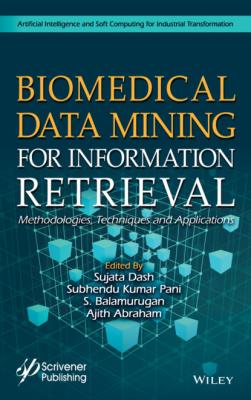Biomedical Data Mining for Information Retrieval. Группа авторов
Чтение книги онлайн.
Читать онлайн книгу Biomedical Data Mining for Information Retrieval - Группа авторов страница 26
 secondary structure at better than 70% accuracy. J. Mol. Biol., 232, 2, 584–599, 1993, https://doi.org/10.1006/jmbi.1993.1413.
secondary structure at better than 70% accuracy. J. Mol. Biol., 232, 2, 584–599, 1993, https://doi.org/10.1006/jmbi.1993.1413.
67. Rost, B., PHD: Predicting one-dimensional protein structure by profile based neural networks. Methods Enzymol., 266, 525–539, 1996, https://doi.org/10.1016/s0076-6879(96)66033-9.
68. Jones, D.T., Protein secondary structure prediction based on positionspecific scoring matrices. J. Mol. Biol., 292, 2, 195–202, 1999.
69. Cuff, J.A., Clamp, M.E., Siddiqui, A.S., Finlaym, M., Barton, G.J., JPred: A consensus secondary structure prediction server. Bioinformatics, 14, 10, 892– 893, 1998.
70. LeCun, Y., Bengio, Y., Hinton, G., Deep learning. Nature, 521, 7553, 436–444, 2015.
71. Zhu, J., Wang, S., Bu, D., Xu, J., Protein threading using residue covariation and deep learning. Bioinformatics, 34, 13, i263–i273, 2018.
72. Xu, J. and Wang, S., Analysis of distance-based protein structure prediction by deep learning in CASP13. Proteins, 87, 12, 1069–1081, 2019, https://doi.org/10.1002/prot.25810.
73. Xu, J., Distance-based protein folding powered by deep learning. Proc. Natl. Acad. Sci. U.S.A., 116, 34, 16856–16865, 2019.
74. Greener, J.G., Kandathil, S.M., Jones, D.T., Deep learning extends de novo protein modelling coverage of genomes using iteratively predicted structural constraints. Nat. Commun., 10, 3977, 2019.
75. Senior, A.W., Evans, R., Jumper, J. et al., Protein structure prediction using multiple deep neural networks in CASP13. Proteins, 87, 12, 1041–1048, 2019, https://doi.org/10.1002/prot.25834. [2] Cao, R., Freitas, C., Chan, L., Sun, M., Jiang, H., Chen, Z., ProLanGO: Protein Function Prediction Using Neural Machine Translation Based on a Recurrent Neural Network. Molecules, 22, 10, 1732, 2017.
76. Qiu, J., Sheffler, W., Baker, D., Noble, W.S., Ranking predicted protein structures with support vector regression. Proteins, 71, 1175–1182, 2007.
77. Joo, H. and Tsai, J., An amino acid code for β-sheet packing structure. Proteins: Structure, Function, and Bioinformatics, Volume 82 (9) – Sep. 1, 2014.
78. Crick, F.H., The packing of α-helices: simple coiled-coils. Acta Crystallogr., 6, 689–697, 1953.
79. von Mering, C., Krause, R., Sne, B. et al., Comparative assessment of large scale data sets of protein–protein interactions. Nature, 417, 6887, 399–403, 2002.
80. Hakes, L., Lovell, S.C., Oliver, S.G. et al., Specificity in protein interactions and its relationship with sequence diversity and coevolution. PNAS, 104, 19, 7999–8004, 2007.
81. Harwell, L.H., Hopfield, J.J., Leibler, S., Murray, A.W., From molecular to modular cell biology. Nature, 402, c47–c52, 999.
82. Jeong, H., Mason, S., Barabási, A.L. et al., Lethality and centrality in protein networks. Nature, 411, 6833, 41–42, 2001.
83. Giot, L. et al., A protein interaction map of Drosophila melanogaster. Science, 302, 1727–1736, 2003.
84. Li, S., Armstrong, C., Bertin, N., A map of the interactome network of the metazoan. Science, 303, 5657, 540–543, 2004.
85. Wuchty, S., Scale-free behavior in protein domain networks. Mol. Biol. Evol., 18, 9, 1694–1702, 2001.
86. del Sol, A. and O’Meara, P., Small-world network approach to identify key residues in protein–protein interaction. Proteins, 58, 3, 672–682, 2004.
87. del Sol, A., Fujihashi, H., O’Meara, P., Topology of small-world networks of protein–protein complex structures. Bioinformatics, 21, 8, 1311–131, 2005.
88. Brohée, S. and van Helden, J., Evaluation of clustering algorithms for protein–protein interaction networks. BMC Bioinf., 7, 48, 2006.
89. Spirin, V. and Mirny, L.A., Protein complexes and functional modules in molecular networks. PNAS, 100, 12123–12128, 2003.
90. Bu, D., Zhao, Y., Cai, L. et al., Topological structure analysis of the protein– protein interaction network in budding yeast. Nucleic Acids Res., 31, 9, 2443– 2450, 2003.
91. Nicolas, J., Artificial intelligence and bioinformatics. 2018, https://doi.org/10.1007/978-3-030-06170-8_7.
92. Dimova, D. and Bajorath, J., Advances in activity cliff research. Mol. Inf., 35, 5, 181–191, 2016.
93. Stumpfe, D., Hu, H., Bajorath, J., Evolving Concept of Activity Cliffs. ACS Omega, 4, 11, 14360–14368, 2019, Published 2019 Aug 26.
94. Kitchen, D.B., Decornez, H., Furr, J.R., Bajorath, J., Docking and scoring in virtual screening for drug discovery: Methods and applications. Nat. Rev. Drug Discovery, 3, 11, 935, 2004.
95. Ferreira, L.G., dos Santos, R.N., Oliva, G., Andricopulo, A.D., Molecular docking and structure-based drug design strategies. Molecules, 20, 7, 13384– 13421, 2015.
96. Dos Santos, R.N., Ferreira, L.G., Andricopulo, A.D., Practices in Molecular Docking and Structure-Based Virtual Screening. Methods Mol. Biol. (Clifton, N.J.), 1762, 31–50, 2018, https://doi.org/10.1007/978-1-4939-7756-7_3.
97. Brown, J.B., Niijima, S., Okuno, Y., Compound–Protein Interaction Prediction Within Chemogenomics: Theoretical Concepts, Practical Usage, and Future Directions. Mol. Inf., 32, 906–921, 2013.
98. Qiu, T., Qiu, J., Feng, J., Wu, D., Yang, Y., Tang, K., Cao, Z., Zhu, R., The recent progress in proteochemometric modelling: Focusing on target descriptors, cross-term descriptors and application scope. Brief Bioinform., 18, 1, 125– 136, 2017.
99. Jackson, M.J., Esnouf, M.P., Winzor, D., Duewer, D., Defining and measuring biological activity: Applying the principles of metrology. Accredit. Qual. Assur., 12, 6, 283–29, 2007, https://doi.org/10.1007/s00769-006-0254-1.
100. Vamathevan, J., Clark, D., Czodrowski, P., Dunham, I., Ferran, E., Lee, G., Li, B., Madabhushi, A., Shah, P., Spitzer, M., Zhao, S., Applications of machine learning in drug discovery and development. Nat. Rev. Drug Discovery, 18, 6, 463–477, 2019, https://doi.org/10.1038/s41573-019-0024-5.
101. Sidey-Gibbons, J. and Sidey-Gibbons, C.J., Machine learning in medicine: A practical introduction. BMC Med. Res. Method., 19, 1, 64, 2019, https://doi.org/10.1186/s12874-019-0681-4.
102. Greene, N., Judson, P.N., Langowski, J.J., Marchantm, C.A., Knowledge-based expert systems for toxicity and metabolism prediction: DEREK, StAR and METEOR. SAR QSAR Environ. Res.,